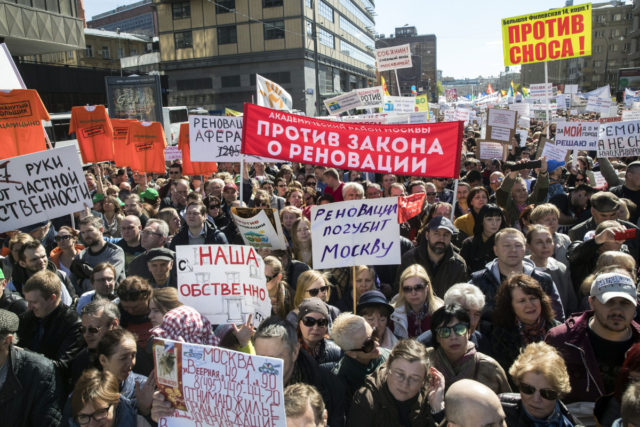
Aging Apartment Block Demolitions Awaken Moscow Regionalist Sentiments
Publication: Eurasia Daily Monitor Volume: 14 Issue: 68
By:

Last February, Russian President Vladimir Putin recommended to the mayor of Moscow, Sergei Sobyanin, that the municipal administration demolish the city’s khrushchevki—five-story apartment buildings built in the 1950s–1960s and colloquially named after Nikita Khrushchev, the Soviet General Secretary at the time. The current residents of the khrushchevki were to be resettled to new housing. Together, this dual process of demolition and resettlement is being euphemistically termed “renovation.” Putin declared that the Muscovites themselves want to demolish these old buildings and move to new housing. In turn, Sobyanin reported the program to resettle the residents will be completed during 2017–2018 (Vedomosti, February 21).
But Putin clearly misunderstood the Muscovites’ mood. The planned “renovation” has sparked a sizeable protest movement in the city. A rally on May 14 against the apartment block demolitions brought out into the streets an estimated 20,000–30,000 people, according to independent sources. This is a fairly large number, particularly given the tightening of legislation related to protests and rallies (see EDM, June 8, 2012; March 27, 30, 2017). During this demonstration, municipal deputies Elena Rusakova and Konstantin Yankauskas delivered particularly sharp speeches, demanding the resignation of Mayor Sobyanin (Newsru.com, May 14).
Moscow is often represented as a single city, but in reality this 12-million-person “megapolis” is divided into 125 districts, each of which has the status of a municipal formation. These municipalities elect their own deputies, although they have little authority in the Russian “vertical of power.” According to official government plans, 4,566 housing units in 85 districts of Moscow are being subjected to demolition (RBC, May 3). Indeed, the bulk of the protests arose in most of these areas. In total, the “renovation” project can be expected to affect 1.6 million people (Rusrand.ru, April 28).
The former far-right Russian nationalist–turned–pro-Western liberal Alexei Shiropaev, who participated in the rally, observed, “The movement against ‘renovation’ stimulates Moscow civil self-consciousness. Here and there, I saw the motley flags of the Moscow districts (such an intra-Muscovite regionalism-patriotism)” (Afterempire.info, May 15). Regionalism in Russia is usually interpreted as the resistance of the regions to Moscow as a center of the empire. However, this phenomenon of Moscow regionalism showed a different, deeper aspect—opposing the power center by Moscow itself as a diverse metropolis. Thus, at the May 14 protest rally, the Muscovites were not acting as residents of the “capital of the empire,” preoccupied in the first place with state ambitions (as the authorities and state propaganda tries to engender—see EDM, April 27), but as citizens of their city and its districts, with their own interests. And this has so far been the main social result of the controversial mass “renovation” plan—one not envisaged by its government initiators.
A paradoxical point can also be discerned from this situation: the endangered five-story buildings clearly belong to the Soviet era, but the protests of their inhabitants are not “Soviet.” The residents are advocating for property rights, since the apartments in these houses were privatized by their tenants in the early 1990s, after the fall of Communism. On the contrary, the current Russian authorities are continuing Soviet-style policies—as exemplified by this attempt at mass forced resettlement (Rusrand.ru, April 28).
Residents of other Russian regions look with some perplexity at the Moscow events. For them it is unclear why the authorities first of all undertook to “renovate” Moscow, while many Russian regions outside the capital are plagued by even larger concentrations of dilapidated houses. Apparently, this is another manifestation of the Soviet tradition—with the center striving to turn Moscow into “a showcase of socialism,” while forgetting about the country’s peripheral cities. Russian anti-corruption blogger and opposition politician Alexei Navalny recently cited official statistics pertaining to the apartment block demolitions and the resettlement of the residents: “The renovation program will require at least two trillion rubles [$35 billion], this number is voiced by Sobyanin himself. This is a colossal amount of money that will be taken from the pockets of not only all Muscovites, but also the inhabitants of the country” (Ekho Moskvy, May 16). If that leads to a further drop in the standard of living in the regions, many other Russian cities might also see an increase in mass protests—directed against both the local authorities and the central government.
An argument could be made that the houses built in the Khrushchev era really are structurally obsolete, although many of them have since undergone major repairs. However, as an alternative for the khrushchevki residents, the authorities offer not private low-rise buildings—popular in Europe and the United States—but even taller, cramped “sleeping quarters.” In other words, the types of high-density apartment blocks that developed countries have long ago abandoned.
According to some experts, from an economic point of view, the “renovation” of the khrushchevki is beneficial to large construction and development companies. The Moscow authorities are prepared to buy from them ready-made apartments for the resettlement of those residents of the five-story buildings. A fairly large amount of new housing has been built in Moscow already. But because of rapid housing price increases, those units have still not been sold and construction companies with links to the Moscow authorities have been losing profits (RBC, April 20).
In addition to economically enriching Moscow developers, the main political goal of the “renovation” program’s authors is apparently to popularize the figure of Vladimir Putin in the Russian capital, where mass protests took place in opposition to him in 2011–2012. However, this is unlikely to help improve Putin’s image in time for the 2018 elections. The present-day situation in Russia (further exemplified by, for example Russian truckers’ protests and this spring’s mass youth anti-corruption demonstrations—see EDM, April 6, 2016; March 27, 30, 2017) is such that any heavy-handed socio-economic initiative by the authorities sparks a negative reaction within Russian society. One hundred years ago, a similar mass social mood erupted in a revolution.



